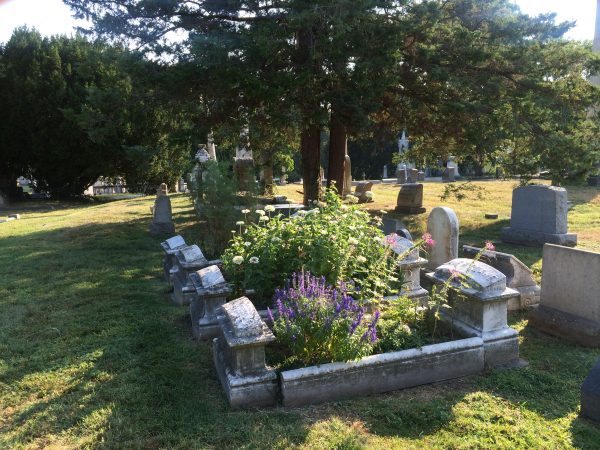By Starr E. Herr-Cardillo
The Woodlands Cemetery is a 54-acre National Historic Landmark in the University City neighborhood in Philadelphia. Formerly the estate of 18th-century botanist and plant collector William Hamilton, The Woodlands was purchased in 1840 when the mansion and picturesque grounds were repurposed as a rural cemetery [1]. Today, the space serves as a community hub and popular green space for the surrounding neighborhood. Our gates are open from dawn to dusk daily welcoming visitors, joggers, dog walkers, and now, Grave Gardeners: volunteers who use their love of gardening to learn about and help maintain our historic site.
The idea
The idea for the Grave Gardeners program grew out of a simple observation. One of the more popular headstone types in the Victorian period was the “cradle grave” or “tombs in the French style” [2]. The markers are essentially container gardens, often with large, elaborate headstones and a bathtub-shaped planting bed extending from the base. The Woodlands Cemetery was incredibly popular during this time period and, as a result, there are hundreds of cradle graves. Once planted and cared for by family members and loved ones, over the course of the last century, the planters had become abandoned. With this in mind, the idea for a program that would pair individual graves with volunteer gardeners who would replant and tend to them was born.

The Grave Gardeners program has been a success for many reasons: it gives people who care about the cemetery an active role in helping beautify and care for it; it generates substantial volunteer hours, which is important as we are a very small staff; it provides historical context, tying into both the Cemetery Company Era and Hamilton Era horticultural history; and, finally, it’s really, really fun.
How it works
We put out a call for applications in January. Gardeners commit to care for their plots from March to October. In February, they attend a series of workshops that we coordinate which provide relevant historical context, basic instruction on gardening, an introduction to heirloom plant varieties, and an overview of how to conduct historical research on their grave residents. In March, we host a prep day where volunteers come to The Woodlands, find their plots, and prep them with compost so that they are ready to garden.
 Beginning in the spring, we host bi-monthly twilight gardening nights and gardening happy hours, which provide a window where gardeners can come work in their plots and have access to our assistance, along with seasonal plant material and seeds that we provide. We also host an annual event to fundraise for the program.
Beginning in the spring, we host bi-monthly twilight gardening nights and gardening happy hours, which provide a window where gardeners can come work in their plots and have access to our assistance, along with seasonal plant material and seeds that we provide. We also host an annual event to fundraise for the program.
Logistics
Our first year we were hoping to bring on about twenty volunteers. We put out a call for applications and received 77 by the due date. We accepted all 77 volunteers. Clearly, the idea had struck a chord and we wanted to include as many people as possible. This year, we have 150 gardeners gardening more than one hundred graves (many people opt to co-garden one plot) [3].
 We also partner with the Pennsylvania Horticultural Society (PHS), who provides assistance and the facilities for our initial workshops. We also tapped a friend, who happens to be an expert in heirloom plants, to help us craft our historically appropriate plant list. The list includes varietals that would have been common in the Philadelphia area in Victorian times and is full of perennials, roses, bulbs, and ferns. Though there is some flexibility in terms of planting things that deviate from the list, the idea is to rely primarily on period-appropriate heirlooms and avoid plants that are clearly modern [4]. Luckily, heirlooms tend to be more fragrant than contemporary varieties and also naturalize readily (meaning they will spread out and re-seed). With assistance from sponsorships, donations, and small grants we are able to provide compost, tools, and the majority of plants, seeds, and bulbs to our volunteers.
We also partner with the Pennsylvania Horticultural Society (PHS), who provides assistance and the facilities for our initial workshops. We also tapped a friend, who happens to be an expert in heirloom plants, to help us craft our historically appropriate plant list. The list includes varietals that would have been common in the Philadelphia area in Victorian times and is full of perennials, roses, bulbs, and ferns. Though there is some flexibility in terms of planting things that deviate from the list, the idea is to rely primarily on period-appropriate heirlooms and avoid plants that are clearly modern [4]. Luckily, heirlooms tend to be more fragrant than contemporary varieties and also naturalize readily (meaning they will spread out and re-seed). With assistance from sponsorships, donations, and small grants we are able to provide compost, tools, and the majority of plants, seeds, and bulbs to our volunteers.
Woodlands as a model
We love the idea of this program serving as a model for other historic cemeteries, which sometimes struggle to attract caretakers and interest in upkeep, and we have learned a lot over the past year and a half. Our program wouldn’t have been nearly as successful as it has had we not reached out to other community partners. Connecting with established organizations and experts gave the program the weight and legitimacy to attract a wide audience, and to really solidify the historic context for participants through lectures and workshops, which was important to us as a National Historic Landmark site. Connecting with local businesses that have provided compost and plant material allowed us to open the program up to a large number of participants and reduce costs. Likewise, we rented space in a local greenhouse this year and began starting many of our plants from seed, which, in addition to being an inexpensive way to offer grave gardeners heirloom plants on the cheap, provided more control over which kinds of plants were being introduced. This year, we are working on saving seeds and propagating plants from existing gardens now that they have had time to establish, which adds another educational dimension to the program.

It has been wonderful to develop this program over the past year and a half, and the gardens have evolved beautifully. The program has built a really wonderful community of volunteers and we can’t wait to see what next year brings!
Notes:




